Relocation is a process that sure seems like it was created to drive people insane. Somehow, everything’s out of order. Still, there are more than a few moving hacks to guide you through the entire process. Apply them, and you’ll find out that there’s no more mysteriously disappearing stuff, that boxes don’t have to create an impassable jungle on your floor, and that family and friends who generously offered their help don’t have to freak out from your ever-changing instructions.
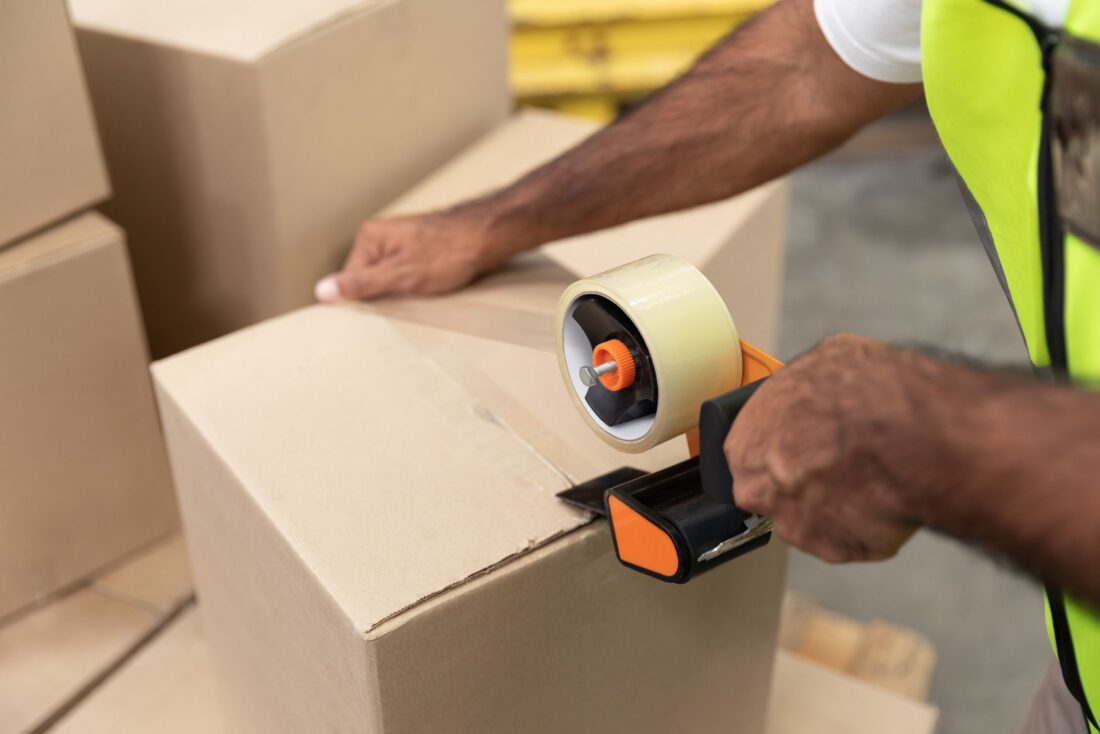

From the moment of the big decision to the testing of the sofa in the new place, with all the in-between steps, we prepared the ultimate list of do’s and a few don’ts for you, along with some really inspiring quotes about moving. Since you probably know all about thousand miles journeys, first steps, and whatnot, let’s get started.
Why Hacks to Make Moving Easier Are Essential?
Your preparations for the relocation should start at the very moment you say something along the lines of “I definitely should change the scenery,” while relaxing in your armchair in front of the TV. Or when you get a call from your boss, and he casually informs you that you’re being transferred to another city.
In an ideal world, those decisions would be made and declared a few months before the event itself. That way, you’d have plenty of space to think about practical questions such as how to find a new doctor when you move, but also the more existential ones. How to move at all, for example. As we’re all aware, those questions tend to do more damage than good if you’re running out of time. To avoid that predicament, you’ll have to organize. So get your hands on a whiteboard and a few markers and start writing.
Moving Tips and Hacks Always Start With a Detailed Checklist
The first relocation tip is to create a to-do list of tasks that await you. After that, you can come up with a schedule for them. When you put it all on a board (or paper, though the board is easier to rewrite, if necessary), you’ll have a general knowledge of the whats and whens of the process.
Doing so will also help you prepare even better for particular tasks. Say, knowing that you’ll be packing books three weeks from now gives you enough space to acquire smaller boxes for them. It can also help with your mental preparations for set administrative dealings. In the end, if something feels too much of a drag, you can always reschedule it on your board, swapping it with some other task. Be careful though, as one misplaced task can create lots of fuss down the line. Consider all the elements when assigning slots in the calendar.
Also, if you’re good at the science commonly known as how to organize important papers, you might want to create sublists, one for every room in your house. Since they’re smaller in size, those can go on a bulletin board or doors of said rooms, if you use sticky paper or tape.
Figure Out a Budget Plan
As with every other effort of this size and intricacy, it’s crucial to have precise numbers in front of you. How much money you have at your disposal, or, if you wish, a moving expenses checklist. The budget has to include shipping costs for your belongings, but also the range of other expenses. You should also pay the insurance for your stuff. Maybe you want to hire a professional long-distance moving company that can help you with the packing process. They certainly aren’t free.
If you’re planning to drive to your new home, calculate the price of gas, overnight accommodation, and food along the way. If you have your family and friends helping you, you’ll probably have to buy some snacks and drinks as a sign of appreciation. And you’ll probably remember more than a few not-so-well-hidden costs, so give relocation budget planning a go and avoid nasty surprises along the way.


Decluttering Your Home Is an Inevitable Step in a Stress-Free Move
Relocation, especially a long-distance one, is a perfect opportunity to get rid of hoarded but unneeded and sometimes even unwanted stuff. So take a tour around the house and do a home inventory. Then it’s time for culling – hence the lists. What travels and what doesn’t? What is to be sold or donated, and what goes in the garbage?
Check out the video below for some super easy tips on how to declutter your place fast.
What to Do With the Suff You Won’t Bring?
That last fate should befall only irreparably damaged stuff, such as broken appliances that have been taking up space in the garage for eons or torn clothes. The rest should go to charity (check out the Goodwill website) or a garage sale. The latter is an excellent way to improve your budget. For example, you can earn a considerable amount by selling still-working but unwanted appliances. Furniture that won’t fit into your new home should also be in the to-sell group. Nothing falls out of the blue, however. There are a few tips on how to have a successful garage sale.
For starters, the main precondition for it is sunny weather. Otherwise, don’t be surprised if no one shows up. If possible, organize it during the weekend, when people have more free time. Also, tell people about it. Put a post on social media and your community’s pages. The more people show up, the more stuff will go away.


Find Reliable Long-Distance Movers to Ship Your Stuff Safely
When it comes to booking long-distance moving services, strive for that perfect combination of lower prices and higher quality. Since relocating is an expansive industry, we’ll save you some time and advise you to check what our Long-Distance USA Movers have to offer you. Not only because when you start to browse companies’ websites, you’ll also undoubtedly find tons of barely comprehensible moving terms. You can also run into many relocation scams, as well.
So, don’t hesitate to call each company and ask them about their moving quote. After a couple of conversations with a couple of customer representatives, compare moving quotes and other data, and choose the one that suits your needs and means.
Info to look for, besides the license and registration, includes whether the company offers insurance, if it engages in auto transport, and what is on their list of non-movable items. While you’re at it, check out the comment section on the website. Too many complaints about broken glasses, damaged furniture, or missing items are clearly a red flag.
Auto Transport
Move your car across the country in an open or enclosed trailer – for an affordable fee. We offer car transport as a standalone service, but you can bundle it with your household move and get a hefty discount.
Learn moreStorage Services
Our spacious climate-controlled units will protect your things until the drop-off. No need to worry about them because all items are labeled and secure, and each customer gets a dedicated unit mixup isn’t possible.
Learn moreMoving Insurance
All your stuff is secure with Long Distance USA Movers, but in case something does happen to it, there’s a moving insurance policy in place. We offer both basic Valuation Coverage and Full Value Protection.
Learn morePacking Hacks for Moving – How to Make the Best Use of Boxes and Everything Else
In the course of every relocation, there comes a time when you have to place all the belongings you haven’t sold or given away into cardboard, plastic, or wooden crates. Or anything else meant for carrying stuff, and even into some things that weren’t designed for such a purpose. But we’ll get to that in a jiff.
Before we delve into other packing tips, make a packing schedule even if you’ve booked professional cross-country moving services. You can’t (and shouldn’t) pack everything in a day or two (unless you’re in the midst of some sort of last-minute relocation, that is).
So start with the rooms you rarely or never use. The garage or attic are prime examples. Then move on to, say, the guest bedroom. And so on until you finally get to the living room, bedrooms, and kitchen. If you’re moving with kids, it may be useful to leave their room for the end, too. With the standard levels of stress that accompany the relocation process, you’d at least want your children to be on your side.


Gather the Necessary Materials
What better task to end the story of initial preparations for relocation than the logistical nightmare of gathering packing materials? Where to find it all, you may ask – all the boxes, bags, papers, tapes, and the famous bubble wrap to pack your fragile belongings. Well, as it turns out, you won’t have to look very far. Every local retailer will have a box or twenty of them in the back room. Liquor stores, too. Their packaging is among the better ones since it has to carry heavy bottles. If you’re on a first-name basis with the owners, you may yet get what you need for free.
Ensure You Label It All Properly
When it comes to cardboard, we have to conclude that every box looks like all the others. Once in them, things can easily get misplaced. So don’t let them and get the labels for the boxes. Use color schemes. Every box with kitchen items gets a green sticker. Maybe even a list of stuff inside it (does wonders for unpacking, trust us). The living room gets blue ones. The bedroom, for example, is red. Bathroom – yellow. Children’s rooms… You get the point.
The thing is, when done correctly and with no exceptions, labeling transforms a cardboard jungle into a nice road. OK, maybe it’s not paved, but at least it’s one you can walk on without getting lost.
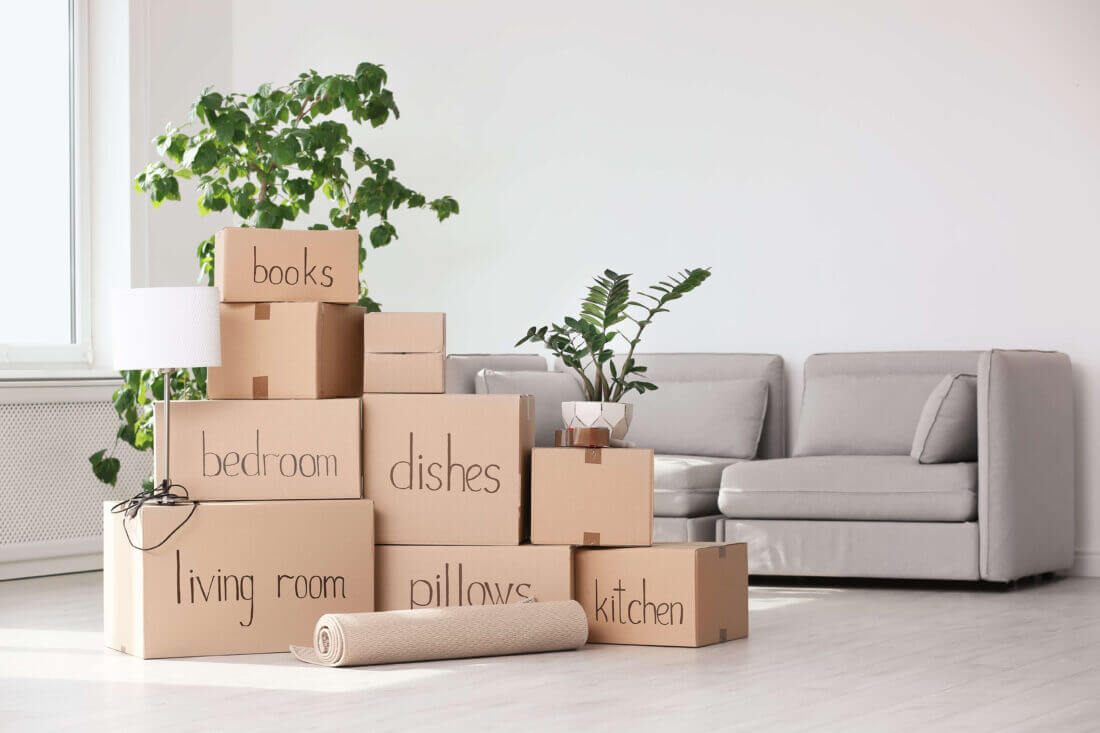

Make It Easier And Safer With Some Additional Simple Life Hacks for Moving
Packing is a mostly dull undertaking. It can even turn out to be dangerous if the crate filled with knives suddenly collapses while being carried to the truck. To avoid that, use some of the moving tips and hacks for the safe wrapping up of your belongings.
So, how to pack an apartment efficiently? It can be easy enough if you follow some simple rules:
- Rule number one says that you always put bigger and heavier items in smaller crates, and vice versa. Books are a prime example of heavy stuff. In that case, though, a wheeled suitcase would serve even better.
- Fill the remaining space in a crate around with leftover materials or old clothes.
- Make carrying easier by cutting in holes in crates to serve as handles.
- Use as many suitcases and bags as possible instead of crates for unbreakable items.
- Disassemble all furniture than can be disassembled. Then collect the screws, put them in a plastic zip bag, and tape it to some part of a furniture piece they belong to.
- Cover all the drawers with sticky plastic wrap, so their content doesn’t end up all around in case they fall out. Then tape the drawers to the dresser, just to be sure.
- Photograph all the cables before you unplug them. Then label them and tie them together in groups. Save yourself time and nerves when it comes to replugging.
- Liquids always go with each other, and nothing else. Best tip on how to pack liquids? Seal them under the cap with foil for no leakages. Of course, don’t do it with a hundred-year-old wine, but it’s perfect for cleaning supplies and such. Beer probably won’t live to see the moving day, so don’t worry about it.
- Wine crates are perfect for the transportation of wine glasses, but also other fragile objects of similar shape.
- Stuff knives into an oven mitt. Then put a rubber band around it all. Now there’s nothing sharp in the utensils organizer to cut through the foil you covered it with.
- Defrost the fridge before the move, with enough time for it to dry.
- Put jewelry inside an egg carton. If you wish to keep necklaces from getting all tangled during the trip, wrap them around a cardboard roll.
And last but not least, don’t deny your friends the opportunity to help you. Invite them to a packing party. With snacks and drinks and chit-chat, it’ll all go down easy. If you don’t believe us, perhaps you’ll take it from His Airness Michael Jordan, who famously said: “Talent wins games, but teamwork and intelligence win championships.” That guy knows what he’s talking about. He won six of those.
If this isn’t enough, proceed with watching the following video and get some more wrapping tips you could use.
Take Special Care of Your Breakables
Naturally, you want your belongings to reach your destination in one piece. So do your part to help them, especially the fragile ones. You can do so with a considerable supply of cushioning materials. Yes, there is bubble wrap, but there are other, more ordinary ways to cushion. Sheets, for example. Or towels. Even socks.
Ever wondered how to pack china for moving? It’s easy; just wrap every piece in a towel and stack them in a crate. Packing dishes? Plates should always go in a crate upright and have a protective layer between them, to prevent them from scratching each other. For that, you can use newspapers, but paper plates can serve as well. And they fit the shape. Another easily breakable bunch is glasses and alike. So put them in socks, for ideal protection. Then there are mirrors. Put tape in the shape of an X across the surface. A minimal price to pay to avoid seven years of bad luck, right? To secure the electronics whose original package you don’t have anymore, apply towels or bubble wrap.
And put a special label on crates with fragile items. That’ll give some idea to people who load the truck, either professional cross-country movers or your friends, to treat them with care. Make sure to reinforce all the boxes with duct tape, and don’t forget to create a backup of computer files. We live in a digital age, after all.


Check Out Some Moving Hacks For Saving Space
Relocation is, in many ways, an art of using every inch of available space. And you can become… well, if not master of it, then at least an aspiring apprentice. If you know how to pack certain things, you may yet save yourself some trouble in the crate-collecting department.
For example, clothes. From an early age, we are taught how to fold them properly. During packing, proper folding is the enemy. Roll up, instead. Rolled-up clothing will take much less space in drawers and bags than folded ones. Here’s another tip for storing clothes during the trip – don’t take them off the hangers. Instead, just put as many pieces as possible in a big garbage bag, together with hangers. That way, when you reach your house, just hang it all in the closet and remove the bag. It’d seem like you haven’t moved at all.
Let’s move on to one handy kitchen tip. You probably have the idea of how to pack pots and pans for moving, but do you know that pots can take the role of storage space for the trip? All you need to do is fill them up with smaller stuff, such as spices, for example.
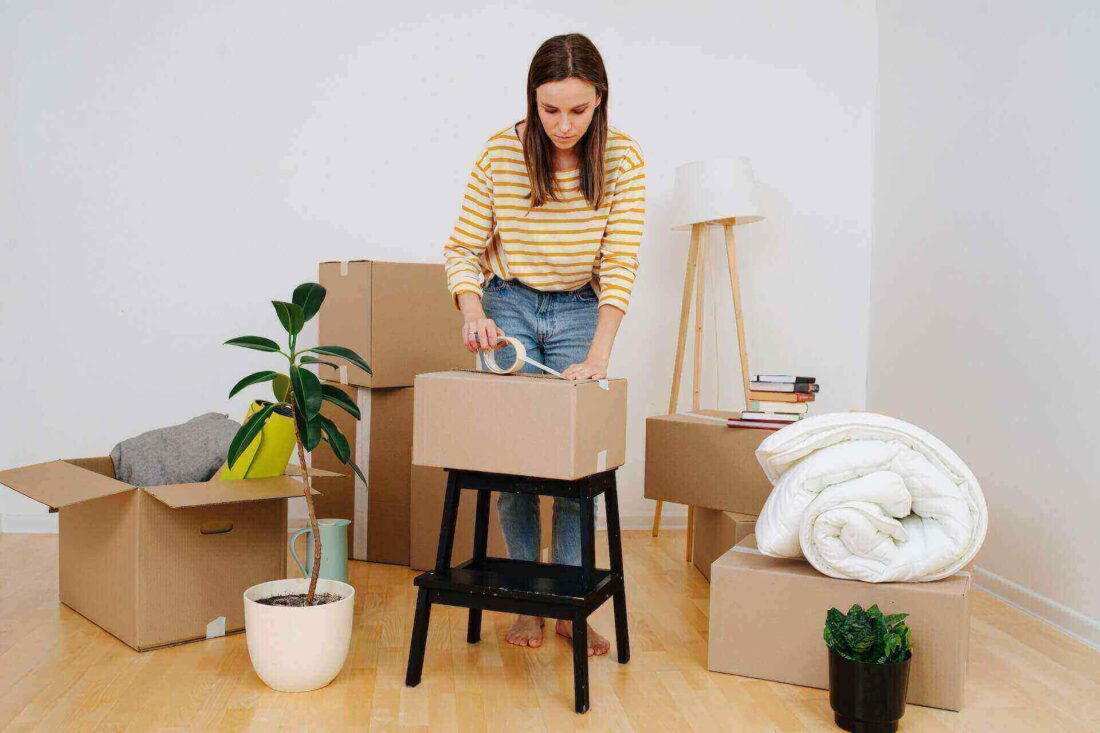

Life Hacks for Moving – How to Get Your Deposit Back
Besides selling belongings that overstayed their welcome, getting back the deposit for a rented apartment is an excellent way to improve the budget. But there’s a catch. Most landlords (we may as well say all of them, but probability and stuff) will take even the slightest dent as a reason to withhold it from you. So ensure that you don’t leave dents.
Do Some Final Cleaning
How can I do that, you may ask? Quite easily, in fact. After most of your belongings are packed, before the final cleaning of the home you are leaving, remove any changes that your furniture might have made on floors and the landlord’s carpets. Put ice cubes into dents in carpets, and when they melt, simply lift fibers with a spoon. If the rug is stained, a simple mix of hydrogen peroxide, water, and a few drops of lemon oil will remove any stain.
Don’t forget the walls. Remove nails with a hammer, but beforehand put a rubber band around the hammer’s head. Doing so will exclude the possibility of damaging the wall. Then fill the nail holes with toothpaste, white soap, or any other suitable material. Once you’re done, take photos. You never know when you’ll need evidence that everything is in order.
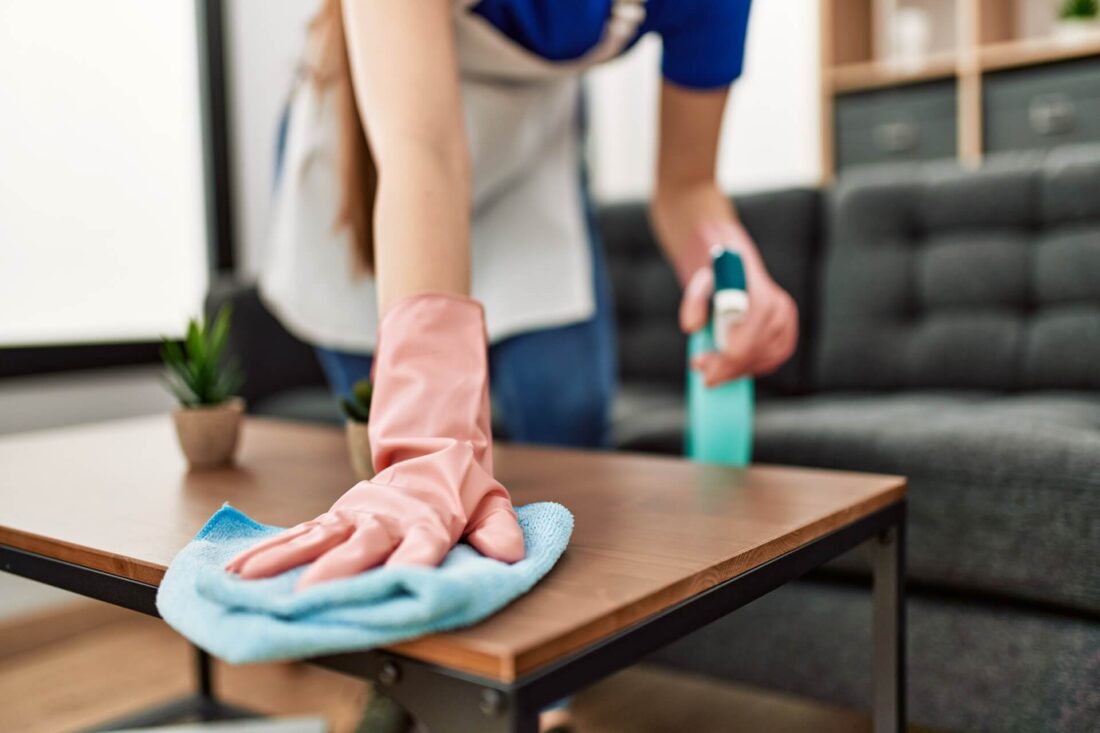

Tips for the Final Day
Do your best to finish wrapping everything up before the moving day itself. When it finally comes around, you should get up early. If you haven’t done that already, buy loads of snacks and bottled water. You’ll need them during the breaks from hard work, whether you’re doing it on your own or with the help of friends or long-distance movers.
Then, do one last tour around the house and pack what eluded you before. Don’t be surprised to find some quite important stuff and yet among the most commonly forgotten things to pack, such as documents or keys. If you have any, it would be a good idea to send kids and pets away while the crates are being moved to and fro, and then pick them up when you set out on the journey.
In case you can’t hire a babysitter, you’ll have to find some other way to keep children and animals out of the way. Pets can be handled quite easily – simply put them in one room, along with food, water, and some toys. Kids, on the other hand, are a more difficult nut to crack. For starters, they can get bored. So give them something to do. Decoration of crates before they are taken sounds pretty good to us. It’ll keep the kids occupied and happy enough to not cause an additional commotion.
Separate the Essentials
A bag of essentials is an absolute must for every relocation. It can be an actual bag, a specially labeled crate, or even a laundry basket, but its contents should consist of stuff that you won’t be able to go without during the trip or the first night in the new home. This package should travel with you, if possible. If not, ensure the essentials are in a transparent plastic package.
In it, you should put all your personal documents, such as an ID card, social security card, passport, and real estate-related documents. Then there are necessary electronic devices, such as laptops and phone chargers. Put a deodorant, soap, and a towel, as well. Can’t hurt to have a sheet and pillows, too, for a good night’s sleep after a long day. Highly valuable stuff should go there, too. Family heirloom jewelry, for example. Kids should have a toy or two among the essentials, as should pets. Snacks and drinks go without saying.
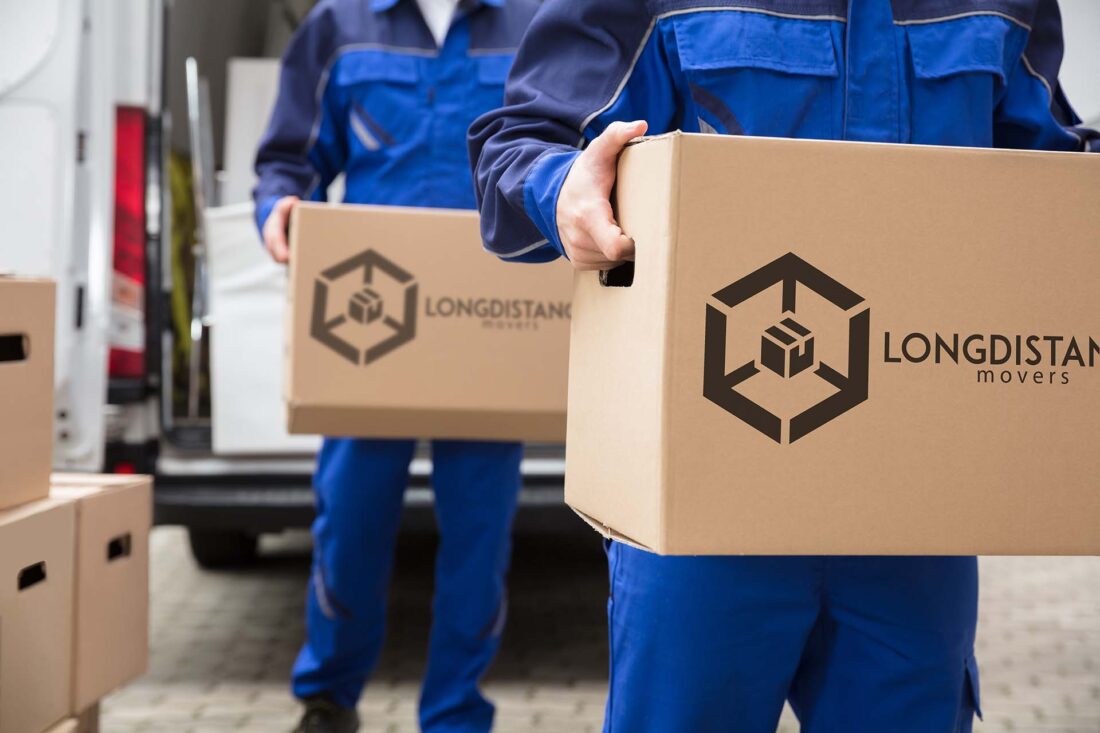

What to Do Upon Arrival, Or Even Before
Cleaning homes, both old and new, should be a priority. If the destination apartment can be cleaned beforehand, so much the better. Also, if you arrive before the truck transporting your belongings, label the rooms with the colors of the crates. Do so, and the people who’ll unload the vehicle will have clear markers for where to take which box.
Then comes the matter of how to unpack after a move. Our advice is to unpack and set up the kitchen first, and then the rest. Be mindful, however. Since there are no fixed deadlines in this phase, you might be tempted by the bliss of procrastination.
“Never put off until tomorrow what can be done day after tomorrow just as well,” said the great Mark Twain. And there’s an appeal to it, no doubt. Still, with unpacking, better heed the adage of Charles Dickens, who said that procrastination is “the thief of time.” Look at it like this: the sooner you empty the crates, the sooner you’ll be rid of them.
If you’re moving with pets, ensure that the space that your furry friend will spend the first days in resembles the old place as much as possible. Animals don’t handle the change of environment well and will take a lot of adjusting before feeling truly at home.
Cancel Subscriptions and Utilities
Before you leave your old address, you should call your utility providers and cancel their services. Do that as soon as possible, since it can easily slip your mind when the process gathers up the pace. Also, if you have subscriptions to some magazines and alike, either cancel them or transfer them to the new address.


With Some Tips and Tricks, a Stress-Free Experience Is Ensured
Anxiety about moving to another state and stress are real things. Luckily, you can minimize the negative feelings or even completely erase them with good organization. So, ensure you have all the needed relocation tips and hacks that will help in this process and make relocating a breeze.
This being said, be sure to check how our Long-Distance USA Movers can help you with this process. Not only do we have the most reliable quote on the market, but our pricing is reasonable too. So, contact us as soon as possible and find out why we’re the best choice for you.
Frequently Asked Questions About Moving Hacks
What are some cost-saving tips for moving?
Getting rid of unnecessary items before packing and moving, asking friends and family to help with the move, but also hiring professional movers are some of the best cost-saving tips when relocating to a new city.
How can I minimize the stress of moving?
It is important to plan ahead and be organized. Start by making a list of tasks that need to be done in advance and prioritize them. Break up large tasks into smaller ones and make sure to schedule time for yourself throughout the process.
What are some packing tips for moving?
Some packing tips for moving include:
- Start early to give yourself plenty of time to pack your items safely and securely,
- Purchase or rent quality packing materials like boxes, tape, bubble wrap, and cushioning materials,
- Label each box with the room it belongs in and a brief description of its contents,
- Put heavier items in smaller boxes and lighter items in larger boxes,
- Wrap fragile or breakable items with bubble wrap or packing paper,
- Pack an overnight bag filled with essentials for your first few days at the new location.
How can I make my move more eco-friendly?
To make your move more eco-friendly, there are several steps you can take. First, try to minimize the number of boxes you need by donating, selling or recycling any items that you no longer need or use. You can also choose reusable containers and materials such as cardboard boxes, and cloth bags.
How can I organize and keep track of my belongings during the move?
To keep track of your belongings during a move, make an inventory list of the items you’re packing and label each box with its contents. Pack items in different categories so you can easily find them when you need to unpack.
What are some tips for moving with pets?
Make the smooth relocation for your furry friends too by following these steps:
- Check with your new landlord or housing complex to make sure that pets are allowed before making the move.
- Make sure your pet is up to date on all vaccinations and has a microchip for identification purposes.
- If possible, try to keep your pet’s routine as similar as possible to minimize stress during the move.
- Make sure to properly secure your pet during the move, either by keeping them in a carrier or on a leash at all times.
- If possible, have someone else take care of your pet for the day or keep them in a temporary boarding facility while you are busy with the move.
What are some things to consider when hiring a moving company?
When hiring a long-distance moving company, it is important to consider their reputation, experience level, cost, and the services they offer. Additionally, ask for references or reviews from past customers so you can get an idea of their reliability.
How can I make my move easier on my kids?
To make the move easier on your kids, there are several steps you can take. Firstly, try to involve them in the decision-making process as much as possible. This could include helping to choose a new home or discussing what they want from the move. Secondly, visit the new area with your family before the move to help familiarize them with the area
How can I ensure the safety of my belongings during the move?
Make sure to pack them properly and securely. Wrap fragile items with bubble wrap or packing paper and use sturdy boxes that are sealed shut with packing tape. Additionally, you can label each box with its contents and keep an inventory of all items so nothing is lost during the move.
What are some last-minute moving tips?
Some last-minute moving tips include: packing early and efficiently, labeling boxes clearly, preparing an essentials bag with items you’ll need on the day of the move, filling out a change of address form ahead of time, arranging for someone to help you with the move if possible, and making sure to have enough supplies like tape, boxes, and bubble wrap.







